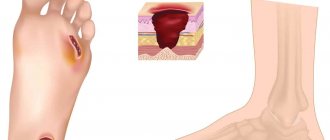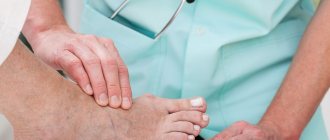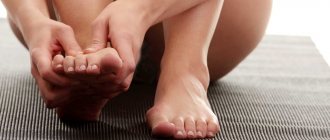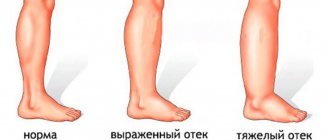Diabetic foot syndrome is a severe complication of diabetes mellitus that occurs in 10–15% of patients. It includes a complex of pathological changes: damage to nerves, blood vessels, soft tissues, joints, bones. Diabetes mellitus is a chronic disease that is accompanied by high levels of glucose in the blood, a serious disruption of many metabolic processes in the body.
It affects 4 to 7% of the population in different countries of the world. Every year the incidence rate is growing rapidly. Now the number of patients exceeds 420 million people. The only effective treatment is to artificially maintain glucose levels within normal limits using insulin injections or taking sugar-lowering medications, depending on the type of diabetes.
How does diabetes affect your feet?
People with diabetes are susceptible to developing a variety of leg problems due to long periods of high blood sugar levels. The main ones are diabetic neuropathy and peripheral vascular disease, which have dangerous health consequences.
In medicine, a complex of disorders in the legs of patients with diabetes mellitus is called diabetic foot.
It is characterized by three pathological conditions:
- neuropathy, nerve damage, which manifests itself in loss of skin sensitivity to various irritants (heat, cold, pain, touch, vibration);
- ischemia or circulatory failure, decreased blood flow to the lower extremities;
- a high risk of infection, nerve damage and poor blood circulation reduces the body's resistance to pathogenic pathogens, complicates the healing of tissues in case of damage and the development of an inflammatory process.
The older the patient and the length of the disease, the higher the risk of diabetic foot.
It most often occurs in people who:
- diabetes experience over 25 years;
- there are problems maintaining blood glucose levels close to normal (diabetes in the stage of decompensation);
- high levels of lipids in the blood;
- increased blood pressure;
- have excess body weight.
Diabetic foot is a very dangerous condition for the feet. With it, even a small cut, wound or rubbing of the skin with shoes that is not at all scary for a healthy person can lead to complications. With diabetes, blisters or wounds often appear on the feet, which become easily infected and take a long time to heal.
They form because due to decreased sensitivity a person may:
- not noticing skin irritation in time;
- not feeling a small pebble or other small foreign object in your shoes and walking with it all day;
- not realizing that the shoes he wears are actually uncomfortable and do not match the shape or size of the foot;
- do not feel any squeezing or rubbing of the skin.
Risk group
All patients with diabetes are at risk for developing diabetic foot syndrome. But the likelihood of developing pathology increases in the following cases:
- the presence of atherosclerosis;
- alcohol and smoking abuse;
- obesity;
- arterial hypertension;
- poor quality hygiene care;
- fungal infection (mycoses);
- cracks, calluses and corns.
Patients at risk are recommended to pay increased attention to the condition of the skin of the lower extremities and undergo regular preventive examinations. The disease can have several forms: ischemic, neuropathic, mixed.
You should be alert to pain that occurs mainly while walking. Such unpleasant signs appear at night, especially when tissue is compressed and blood flow is disrupted. One of the signs of the development of pathology is a violation of the sensitivity of the skin.
The neuropathic type of the disease is most often diagnosed. It occurs when the nerve structures of the limbs are damaged. Patients complain of dry skin, the manifestation of candidiasis, impaired sensitivity, a tendency to bone deformation and spontaneous fractures. They can appear due to an accidental fall on the street or at home, or careless movements.
The ischemic form of the pathology develops as a result of vascular damage. Due to impaired blood circulation and oxygen starvation, the skin of the distal parts of the extremities swells, and pain occurs while walking. Additionally, blisters may appear. Some people develop age spots in their lower extremities. In the mixed form of the disease, both trophic changes and lesions that arise from dysfunction of the nervous structures can occur. This type of pathology appears mainly in patients who have suffered from diabetes mellitus for several decades.
Types of disease
Depending on whether the nerves or blood vessels are affected, the following classification of diabetic foot is accepted in medicine:
- Neuropathic. With this type, nerve endings are damaged (polyneuropathy), their sensitivity decreases, and the pain and temperature threshold decreases;
- Ischemic. With this type, vascular damage occurs. Due to the thickening of the walls, the clearance decreases, blood supply and nutrition to the legs decrease. In diabetes, macroangiopathy and microangiopathy develop. With macroangiopathy, large vessels are affected, and the progression of atherosclerosis in the vessels of the heart and lower extremities is accelerated. With microangiopathy, capillaries are damaged;
- Neuroischemic, simultaneous damage to nerves and blood vessels. This type manifests itself as a combination of the previous two.
In practice, neuropathic (66% of cases) and neuroischemic forms are more common.
Symptoms
Everyone diagnosed with diabetes has heard the phrase “diabetic foot.” The endocrinologist always warns that this is an insidious disease, asymptomatic, but fraught with dangerous late complications. If you do not keep your sugar level, diabetes inevitably affects the kidneys, eyes, and legs. Unfortunately, not everyone understands how serious these complications are until they are faced with them.
It is very important to know the first symptoms of diabetic foot so that you can take action right away.
At an early stage, only small changes are observed, which many do not pay attention to:
- the skin becomes dry, begins to peel, crack;
- hyperkeratosis appears (thickening, keratinization);
- corns, calluses, ingrown nails form, and nail fungus may develop;
- sensitivity decreases slightly;
- Wounds, cuts, and abrasions take a long time to heal.
In the absence of proper glycemic control and treatment at the initial stage of diabetic foot, the disease progresses rapidly.
The signs of diabetic neuropathy depend on which nerves are affected. In some patients, nerve damage does not cause symptoms.
Others get:
- numbness, feeling of chilliness;
- burning, tingling;
- pain in the feet, legs, toes, hands;
- redness of the skin of the feet;
- increased sweating of the feet;
- reduction in the volume of the lower leg muscles;
- loss of temperature sensitivity.
When large nerve fibers are damaged, there is no sensitivity to finger movements, problems with maintaining balance, and pathological changes in the joints appear.
The following symptoms indicate impaired blood flow to the lower extremities with “diabetic foot”:
- the skin becomes pale and cool to the touch;
- swelling appears;
- toes become bluish;
- hair growth on the legs decreases;
- legs get tired quickly after walking for a short time;
- I am bothered by cramps in the calf muscles.
What to look for
Tenderness in the lower extremities
a person does not lose immediately, it is a slow process. The first symptoms are pain and “pins and needles” in the feet. Regardless of whether physical activity has taken place, a person may experience pain, burning and tingling in the feet. Many people tend to ignore such signals or self-medicate using gels and ointments that can relieve discomfort, but not the cause. Over time, the person stops paying attention to the pain, and then the pain goes away because the limbs lose sensitivity.
With the loss of sensitivity, not only pain sensations disappear
, but also
the ability to sense temperature differences
. Because of this, it is easy to get frostbite in winter or accidentally injure your leg without even paying attention to the injury. It must be remembered that sensitivity may disappear, but vulnerability remains, so it is worth making it a rule to conduct regular self-examinations of the feet to avoid wounds and cuts.
How to determine the severity of foot damage?
People with “diabetic foot” need to undergo a full examination at least once a year, which includes an assessment of the condition of their feet. Early diagnosis is very important for timely treatment of identified problems. Consultation with a neurologist, surgeon, vascular surgeon, or podiatrist is necessary. Leg disorders most often develop slowly. It is important to evaluate the condition over time in order to identify minimal deviations at the initial stage.
The podiatrist checks the condition of the skin of the feet, the presence of calluses, and areas of hyperkeratosis. Checks feet for fungal infections, cracks, and foot deformities. If necessary, treats feet and prescribes treatment.
Assessment of vascular condition
The vascular surgeon assesses the condition of the skin of the legs, feels their pulsation, and measures the pressure on the popliteal and femoral arteries. For a more detailed analysis of blood flow in the legs, rheovasography and Dopplerography of the vessels of the lower extremities are prescribed. These methods make it possible to determine the speed and nature of blood movement, the condition of the vascular walls, vascular patency, the intensity and volume of blood flow.
Sensitivity assessment
The neurologist checks reflexes with a neurological hammer, temperature, tactile, pain, and vibration sensitivity of the legs.
The doctor checks tactile sensitivity using a simple monofilament test. Monofilament is a piece of nylon thread weighing 10 g, secured in a convenient holder. During diagnosis, it is placed so that it is located perpendicular to the skin. In this case, at the moment of contact, the monofilament should reach a bent state. The doctor touches certain points on the plantar part of the foot for 1.5 seconds, and then asks the patient about the sensations. If a person does not feel pressure when touching the monofilament, then sensitivity is weakened. And such a patient belongs to the risk group for developing foot wounds.
Vibration sensitivity in diabetic feet is analyzed using a graduated tuning fork with a frequency of 128 Hz. After installing its leg on a certain area of the leg or foot, the duration of the patient’s sensation of vibrations is assessed.
Pain sensitivity is tested by applying tingling stimulation with a needle.
Temperature sensitivity is determined by a “Tip-therm” tester, one end of which is made of plastic and the other of metal. The doctor alternately touches the big toe, dorsum of the foot, inner ankle, and skin of the lower leg with metal (cold) and plastic (warm) surfaces. Normally, the patient should feel the touch of these materials differently.
Self check
To independently assess the sensitivity of your feet to touch, you can use a feather or a piece of cotton wool. It’s easy to run it along the sole of your foot and analyze your sensations. Temperature sensitivity can be checked by touching hot or cold water first with your hand and then with your foot and comparing the sensations. Normally they should be the same. If you feel that the water is hot with your hand, but not with your foot. This may indicate a loss of the ability to sense temperature.
Self-diagnosis does not provide an objective assessment of the situation, so it is better to see a doctor and undergo standard tests.
Treatment by an endocrinologist at the Paracelsus clinic, Sergiev Posad
At the Paracelsus Medical Center, patients are treated by endocrinologists with at least 11 years of experience.
You can be examined and treated by a doctor of medical sciences with 37 years of experience in endocrinology.
We invite you to our medical center for diagnosis and treatment if alarming symptoms of diabetic foot syndrome appear.
Diagnosis of diabetic foot
The process of making a diagnosis begins with a conversation with a doctor, collecting complaints, and medical history data. Then inspect the changes. At the initial consultation stage, the doctor will determine the need for consultation with other specialists - orthopedic traumatologist, vascular surgeon, neurologist, surgeon.
In medicine, an integrated approach is used to treat complex diseases. The patient will be able to get advice from all the necessary specialists in our center.
Diagnosis is carried out using laboratory and instrumental methods. The laboratory diagnostic plan includes:
- clinical blood test;
- blood chemistry;
- analysis of the amount of hormones;
Instrumental diagnostics at the Paracelsus clinic are carried out using expert-class equipment. An ultrasound examination will be performed to assess the condition of blood vessels and nerve fibers.
Complications of diabetic foot
Impaired blood circulation and metabolic processes prevent the supply of oxygen and nutrients to the tissues of the leg and foot, and complicate the removal of metabolic products. Local immunity and resistance to infections decreases. Trophic changes occur.
Complications of diabetic foot can be very sad, including the loss of a limb to save life. According to statistics, this happens in 20% of patients.
Complications that develop against the background of damage to nerves and blood vessels include:
- skin and bone infections;
- deformation of the joints and bones of the foot;
- ulcers;
- gangrene.
Infections
Even a slight violation of the integrity of the skin on the lower leg or foot with uncontrolled diabetes mellitus can lead to infection. High blood sugar levels, poor blood supply, and decreased immunity create favorable conditions for the development and proliferation of pathogenic microflora. If a person with diabetic foot is injured, cut, scratched, or rubbed his foot, he needs to treat the damaged surface with an antiseptic as soon as possible and monitor it. If healing does not occur and the condition worsens, you should see a doctor.
The fact is that an untreated superficial foot infection poses a potential threat to the entire limb. It easily spreads in depth and breadth, affecting neighboring tissues. The more advanced the condition, the more difficult it will be to cope with it.
Diabetes mellitus increases the risk of developing osteomyelitis, a severe infection of the bones of the foot.
Fungal infections of the nails (onychomycosis) and skin of the feet are much more common in people with diabetes. Nails infected with fungus become thick, discolored, yellowish-brown, and lose their transparency. They easily break, erode, and separate from the nail bed, which can cause wounds.
Foot deformities
Damage to the nerves in diabetes weakens muscle tone, reduces their motor activity, and gradually causes atrophy. This leads to deformation of the foot, changes in support points, incorrect distribution of body weight, and gait disturbance. Longitudinal and transverse flat feet develop, and the ankle joint changes. The toes take on a hammer-shaped appearance, and the metatarsal heads may protrude. Areas of hyperkeratosis form on the protrusions.
Severe foot deformities in diabetes mellitus include Charcot arthropathy. This is a rare complication that causes weakening of the bones. It is characterized by dislocations, fractures of bones and joints with the formation of an unstable foot, full support on which becomes impossible.
Ulcers
Trophic ulcers are a dangerous complication of diabetic foot. The reason for their development can be small scratches, cuts, or scuffs of shoes. If not treated in a timely manner, deep wounds do not heal for a long time, leading to suppuration, tissue necrosis, and reaching the bone. They most often form on the ball of the foot or the bottom of the big toe. According to statistics, such ulcers occur in 20% of people with diabetes.
At the initial stage of ulcers, small watery blisters appear on the skin, in place of which a wound then forms, which gradually increases in size. Swelling, irritation, and an unpleasant odor may also occur. Sometimes timely diagnosis of ulcers is difficult; symptoms do not appear until infection occurs.
According to statistics, more than 50% of ulcers are complicated by infection. You can see what a diabetic foot with complications looks like on the Internet. Looking at such photos is enough to understand how dangerous they are. Neglecting ulcers can lead to infections, which in turn can lead to limb loss.
Very often, for people who do not yet know that they have diabetes, a long-term non-healing ulcer on the leg becomes the reason for visiting a doctor, and is regarded as the first sign by which a person is diagnosed with this diagnosis.
Gangrene
Gangrene is necrosis (death) of tissues of a living organism. The main reason for its development is tissue ischemia caused by insufficient blood supply. The first signs of gangrene: areas of necrosis, blackening of the skin, trophic ulcers.
Treatment of gangrene is very difficult and in most cases leads to disability. To save a person's life, doctors have to amputate the affected part of the limb or the entire limb so that the infection does not spread to the entire body. If the disease is suspected at an early stage, the leg can be saved only if blood circulation in the legs is restored through vascular surgery.
Treatment
The most effective treatment for diabetic foot is preventative. It will help protect your legs from developing severe complications. The main task is frequent monitoring and correction of glucose levels with sugar-lowering drugs or insulin. To check your blood sugar at home, it is convenient to use a glucometer.
If signs of diabetic foot appear (numbness, pain, burning, pallor, coldness), you should immediately consult a doctor. Among the drugs, medications can be prescribed to treat neuropathy, drugs that improve blood circulation, metabolic processes, and physiotherapy.
If it comes to ulcers and purulent complications, then how to treat diabetic foot depends on the degree and depth of tissue damage. To make sure that the bone is not infected, the doctor orders an x-ray. If detected early, leg ulcers can be treated. For treatment, infected tissues and dead particles are cleaned, and infected tissue is collected for a culture tank to identify the type of pathogen and determine its resistance to antibiotics.
Antibiotics are used in the form of ointments or injections. Dressings are also prescribed to keep the wound clean and dry, and medications that accelerate tissue healing and relieve pain. Until the ulcer heals, the person is advised to unload the foot, rest and a gentle regime. Do not put any weight on your sore leg, as the pressure from walking will aggravate the infection and expand the ulcer. To protect the wound surface, the doctor may prescribe special shoes and gauze bandages.
If the ulcer does not heal for a long time and there are signs of circulatory disorders, a consultation with a vascular surgeon is indicated to resolve the issue of revascularization. Restoring adequate arterial blood supply is necessary for wound healing and eliminating foci of infection. For this purpose, bypass surgery, stenting, and angioplasty are used.
Infections that cannot be treated may require amputation.
Diagnostics
At the appointment, the specialist conducts an examination and prescribes a comprehensive examination. Diagnosis can be carried out not only by an endocrinologist, but also by a podologist, as well as a vascular surgeon and orthopedist. In our clinic, you will be referred to the right specialist so that the doctor can conduct a high-quality and comprehensive examination. The clinic is equipped with high-quality equipment for laboratory and instrumental diagnostics.
It is extremely important to assess the patient’s general health in order to make a definite prognosis for recovery and identify concomitant disorders and diseases that require additional correction. The doctor also determines further measures aimed at correcting the disorder and preventing adverse health consequences.
Examination of patients includes the following procedures and techniques:
- collecting anamnesis, careful examination of the skin, identifying characteristic changes, signs of swelling and increased pain, curvature of joints;
- determination of the ankle-brachial index, reflex activity;
- assessment of tactile, temperature, vibration sensitivity;
- Doppler ultrasound of leg vessels;
- angiography with contrast, CT arteriography;
- radiography.
Specialists also study the results of laboratory procedures and pay increased attention to blood glucose levels, cholesterol levels, determination of ketone bodies and sugar levels in urine.
Features of diabetic foot care
Decompensated diabetes leads to serious foot problems, but these can be prevented or at least minimized. According to statistics, up to 85% of all amputations due to diabetic foot can be successfully prevented. To do this, you need to constantly monitor and maintain normal blood sugar levels, properly care for your feet, and regularly check their condition yourself and with specialized doctors.
Hygiene
If you have diabetic feet, it is very important to keep your feet clean by washing them daily. To do this, use soap and warm water with a temperature around 33 – 35 °C. To check if the water is not hot before swimming, test it with your elbow first. When washing your feet, be careful, do not make sudden movements, use a soft washcloth or sponge. To remove rough skin, gently rub areas where calluses form with a fine-grained pumice stone. After washing, dry your skin and pat it dry with a towel. Pay special attention to the area between your fingers. For convenience, absorb any remaining moisture with a paper towel.
After bathing, apply a moisturizing cream or lotion to the skin of your feet to avoid dryness, flaking, irritation and cracking, and make the skin soft and smooth. The cream should have the most natural composition without chemical flavors and dyes. Avoid applying moisturizer between your fingers. Excess moisture there can cause a fungal infection. To keep the area between your toes dry, treat it with talcum powder or cornstarch.
Pedicure
The best procedure to tidy up your nails and skin is considered to be a hardware medical pedicure for diabetic feet. It will relieve calluses, corns, nail fungus and other problems without injuring thin, easily wounded skin. This procedure should be performed in centers where there is a podiatrist.
Never treat calluses yourself. When the nerves in the feet are damaged, calluses can eventually turn into ulcers. Contact a podiatrist who will remove them safely and advise you on how to prevent these formations in the future and how to take care of your feet yourself.
How to take care of diabetic feet yourself? At home, you can only carefully trim your nails in a straight line. Do not round the edges of the nail plate, as this leads to ingrown nails. After trimming, smooth the sharp ends with a nail file. If you have any problems with your nails, contact your podiatrist immediately.
Inspection
If you have diabetic foot, you need to examine your feet every day. This will help you detect problems at an early stage and take immediate action. Carry out the examination at the same time so that this activity becomes a habit. For example, every evening before going to bed.
Check availability:
- cuts;
- blisters;
- cracks;
- redness;
- swelling;
- calluses, warts;
- ingrown nails;
- changes in color or deformation of the nail plate.
For ease of inspection, use a magnifying mirror. If you can’t carefully examine your feet yourself, ask your loved ones for help. If you notice anything suspicious, contact your doctor immediately.
Shoes and socks
If you have diabetic feet, it is important to choose the right shoes and socks. Don't walk barefoot, even at home. Always wear socks or slippers, because at any moment there is a risk of stepping on something with your bare foot, getting a scratch or a cut. If your feet get cold at night, wear socks at night. To warm your feet, do not use a heating pad, only warm socks. Due to decreased sensitivity in the feet, there is a risk of getting burned.
Change your socks daily to keep them clean and dry. It is better to buy special medical socks for diabetics. They are made of natural soft materials that do not cause irritation. They do not squeeze the leg above the ankle, fit loosely around the calves, eliminate unpleasant odor, and wick away moisture well.
If your feet are cold, it is recommended to wear socks all the time.
If you have diabetic feet, your feet should always be kept warm and dry. Choose high-quality shoes so that they do not get wet in the rain and do not freeze in winter.
Shoes should be comfortable, provide reliable support and shock absorption for the heel and arches of the feet. Avoid tight shoes, high heels, and narrow-toed shoes that pinch your toes.
To choose shoes that will fit exactly, consult a podiatrist. The doctor will give his recommendations taking into account the anatomical features of your foot. If your feet have changed shape, such as Charcot foot, special orthopedic boots or shoe inserts are recommended. You may also need orthotic inserts if you have calluses, bunions, or hammertoes.
Buy new shoes at the end of the day, when your feet are at their largest size. This will ensure the best fit for your shoes.
Before putting on shoes, always check that there are no small pebbles or other foreign objects. If your feet sweat a lot, use antiperspirants or talcum powder before putting on shoes to keep your feet dry. Remember that excess moisture promotes the development of fungal and bacterial infections.
Another point in preventive treatment is proper unloading and shock absorption of the foot. For this purpose, comfortable shoes and special insoles are prescribed. They reduce pressure on the feet, prevent the formation of corns, the appearance of chafing, and ulcerations.
Requirements for shoes for diabetic feet:
- wide square toe;
- thick sole;
- natural breathable materials;
- lightness, softness, flexibility;
- no rough seams that can rub the skin.
If you have had ulcers on the bottom of your feet, you may need special shoes after they heal. Scar tissue under a healed wound is easily injured. It is important to protect her to prevent relapse. Special shoes will allow you to redistribute the pressure under the foot, reduce the load in the area of the former ulcer, transfer it to areas with intact skin, and increase shock absorption under the sole in places of overload.
Checklist for an appointment with a specialist
Below are questions to answer which you will understand whether you need to consult a dermatologist, mycologist or podologist.
- Do you notice peeling skin around your toes?
- Has the nail plate changed (appearance of a ribbed nail structure, change in nail color)?
- Do you experience pain when walking in the area of the nail plate or at the site of the callus?
- Have you ever had a nail injury that turned your nail color blue or burgundy?
- Have you ever experienced cracked heels?
If you answered yes to several of the above questions, then you need to consult a dermatologist. Dermatologists and podologists at our medical center are proficient in hardware pedicure techniques and non-surgical treatment of ingrown toenails.
What should you not do with your feet if you have diabetes?
When caring for your feet if you have diabetes, you should not:
- cut nails with rounded edges, only in a straight line;
- trim the cuticle, as this is fraught with inflammation, you can carefully move it aside;
- take hot or cold foot baths;
- rub wet feet with a towel;
- walk barefoot to avoid injuring your feet and getting an infection;
- use products to soften calluses, try to remove them with anti-callus patches or sharp instruments;
- use cutting objects for pedicure;
- smear damaged skin on the legs (scratches, cuts, abrasions) with products containing alcohol (iodine, brilliant green); instead, use aqueous solutions of antiseptics (Chlogexidine, Furacilin, Dioxidin).
How to improve blood circulation in the legs?
To prevent diabetic foot complications, it is important to maintain good blood circulation in the extremities.
To do this, do leg exercises daily and maintain general physical activity:
- wiggle your toes throughout the day;
- make movements in the ankle joints, pull the toe away from you and towards you, rotate clockwise and counterclockwise;
- Walk more, swim, ride a bike, if there are no contraindications.
If you have a sedentary job, try to get up and walk around a little every hour. While you are sitting, keep your legs in a position that does not impede blood circulation. To do this, space them out slightly. At the same time, your feet should be completely on the floor, wiggle your toes. If possible, elevate your legs, for example by placing them on a stool. Never sit cross-legged for long periods of time. This way you compress the vessels and further reduce blood flow to the feet.
Smoking poses a major threat to your feet. If you suffer from this bad habit, be sure to quit. If you can’t quit on your own, seek professional help from a psychologist. Smoking has a bad effect on the entire cardiovascular system, reduces blood flow to the legs, and contributes to clogged arteries. Accelerates damage to small blood vessels in the feet and legs. Statistically, many people with diabetes who need amputation are smokers.











